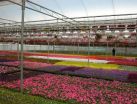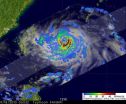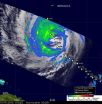(Press-News.org) EAST LANSING, MI—When consumers visit garden centers in spring they will most likely buy flowering ornamental plants that are ready for their home gardens. Studies have shown that consumers favor plants that are already in flower rather than those that are "vegetative"—a preference that can present multiple challenges for commercial growers.
To satisfy consumers' wishes, producers of ready-to-flower ornamentals like bedding plants and perennials start growing crops far in advance of the spring buying season, often during the dark and short days of winter. When the days are short, commercial growers turn to "light manipulation" techniques that either promote or prevent flowering in preparation for delivery to markets. New research from a team at Michigan State University offers commercial plant producers a cost-effective method for producing market-ready plants that appeal to both consumers and retailers.
"Long-day" plants are varieties in which flowering is promoted under short periods of darkness, whereas "short-day" plants flower when the dark period exceeds a critical duration. To satisfy spring markets, some commercial ornamental growers create artificial long-day (LD) environments to produce flowering plants for delivery to retailers. Growers employ several methods to promote flowering in LD plants under natural short photoperiods. Methods include extending day length with artificial lighting, shortening the period of darkness by providing night-interruption (NI) lighting, or using cyclic or intermittent lighting during which incandescent lamps are turned on and off at specific intervals for a certain duration.
Matthew G. Blanchard and Erik S. Runkle from the Department of Horticulture at Michigan State designed an experiment to evaluate a technology for long-day lighting for commercial production of ornamentals. The experiment used four popular flowering ornamentals (campanula, coreopsis, petunia, and rudbeckia) to compare the efficacy of a rotating high-pressure sodium lamp (HPS) in promoting flowering with night-interruption lighting using incandescent lamps.
Seedlings were grown under natural short-day photoperiods (12 hours or less) and night-interruption treatments were delivered from a rotating HPS lamp mounted at one gable end of the greenhouse or from incandescent lamps that were illuminated continuously for four hours or cyclically for 6 minutes every 30 minutes for 4 hours. Within 16 weeks, 80% or more of the plants of each species that received night-interruption lighting had a visible flower bud or inflorescence; all species but petunia remained vegetative under the short-day treatment. Flowering of all species grown at 13 meters from the rotating HPS lamp was delayed by 14 to 31 days compared with those under continuous incandescent illumination.
The researchers estimated that the weekly cost to operate night-interruption lighting was an impressive 80% to 83% less than the cost of continuous incandescent lighting. According to Blanchard and Runkle, "a rotating HPS lamp operated continuously during a 4-hour night-interruption was effective at promoting flowering in these long-day species and consumed less energy compared with incandescent lamps operated continuously." The researchers concluded that use of rotating high-pressure sodium lamps could be effective in commercial production as long as the light intensity is above the recommended value.
INFORMATION:
The complete study and abstract are available on the ASHS HortScience electronic journal web site: http://hortsci.ashspublications.org/cgi/content/abstract/45/2/236
Founded in 1903, the American Society for Horticultural Science (ASHS) is the largest organization dedicated to advancing all facets of horticultural research, education, and application. More information at ashs.org
Rotating high-pressure sodium lamps provide flowering plants for spring markets
Intermittent light system more cost-effective than incandescent illumination
2010-09-21
ELSE PRESS RELEASES FROM THIS DATE:
NASA sees Tropical Storm Julia getting 'dusted'
2010-09-21
Dust has been blowing into the Eastern Atlantic Ocean from Africa's Saharan Desert, and a NASA satellite captured some of that dust east of Tropical Storm Julia.
NASA's Moderate Resolution Imaging Spectroradiometer (MODIS) instrument on the Terra satellite captured a visible image of Tropical Storm Julia on Sept. 18 at 13:50 UTC (9:50 a.m. EDT) and noticed a large area of Saharan dust over the Atlantic Ocean, to Julia's east.
On Sept. 20 at 5 a.m. EDT, Julia was still holding on to tropical storm status with maximum sustained winds near 45 mph. Julia was located about ...
NASA satellites and aircraft studied Hurricane Karl before it faded
2010-09-21
Hurricane Karl made landfall near Veracruz, Mexico on Friday, Sept. 17 and moved inland over Mexico's rugged terrain, which took the punch out of the storm. As Karl was moving into Mexico, NASA aircraft and NASA satellites were gathering data from this storm that jumped from a tropical storm to a Category 3 hurricane the day before.
Karl had maximum sustained winds of 115 mph when it made landfall on Friday afternoon, Sept. 17. That made Karl a Category three hurricane on the Saffir-Simpson scale, and a major hurricane to boot.
On that day, NASA's Genesis and Rapid ...
Winter drought stress can delay flowering, prevent fruit loss in orange crops
2010-09-21
LAKE ALFRED, FL—Successful mechanical harvesting of perennial fruit crops requires efficient, economical harvesting systems that do not reduce trees' production life or diminish fruit quality. Most of the world's citrus is now harvested manually, but the use of efficient and lower-cost mechanical harvesting techniques is expected to increase in the next few years, especially in the large citrus plantations in Florida and Brazil. The citrus industry is ramping up efforts to extend the harvest season past June, when the following year's crop becomes large enough to be susceptible ...
NASA captures very heavy rain in Typhoon Fanapi and 2 landfalls
2010-09-21
Taiwan experienced a landfall and a soaking from Typhoon Fanapi, and NASA and JAXA's TRMM satellite noted a large area of very heavy rain in the system before it made landfall this weekend. NASA's Aqua and Terra satellites also captured impressive visible images of Fanapi just before the Taiwan landfall, and as it was making landfall in eastern China very early today.
The Tropical Rainfall Measuring Mission satellite known as TRMM captured an image of Typhoon Fanapi's rainfall on Sept. 18 at 0653 UTC (2:53 a.m. EDT) after the typhoon had intensified to 105 knots (~121 ...
Introducing 'Champagne', new disease-resistant fig
2010-09-21
BATON ROUGE, LA—The ancient fig tree, first imported to the United States during the 16th century, thrives in areas of California and the South Atlantic and Gulf Coast areas of the U.S. One of the most popular trees grown in Southern backyards, fig is favored for its versatile fruit and low-maintenance production.
Charles E. Johnson, Ed O'Rourke, and James E. Boudreaux, from the Louisiana State University Agricultural Center in Baton Rouge, introduced a new fig they named "Champagne" in a recent issue of HortScience. According to the report, the new fig performed well ...
NASA's MODIS and AIRS instruments watch Igor changing shape, warming over 3 days
2010-09-21
The Moderate Resolution Imaging Spectroradiometer or MODIS, is an instrument that flies on NASA's Aqua and Terra satellites and provides incredible views of tropical cyclones like Hurricane Igor, from its vantage point in space. Imagery from the MODIS instruments on these two satellites captured from Sept. 18 to 20 showed that powerful Hurricane Igor in the Atlantic Ocean is morphing from a rounded storm to more of a comma-shaped storm.
The MODIS instrument on NASA's Terra satellite captured a visible image of Igor at 11:30 am on Sept. 18, while MODIS in the Aqua satellite ...
Food for thought, er, well...
2010-09-21
Ever wonder why it's such an effort to forget about work while on vacation or to silence that annoying song that's playing over and over in your head?
Mathematicians at Case Western Reserve University may have part of the answer.
They've found that just as thinking burns energy, stopping a thought burns energy - like stopping a truck on a downhill slope.
"Maybe this explains why it is so tiring to relax and think about nothing," said Daniela Calvetti, professor of mathematics, and one of the authors of a new brain study. Their work is published in an advanced online ...
Low-calorie cheesecake? Why we have trouble estimating calories
2010-09-21
When it comes to estimating calorie counts, Americans aren't really on the ball. According to a new study in the Journal of Consumer Research, this may be because of the order in which we encounter the food.
"The sequence in which items are considered often influences our evaluations of these items," writes author Alexander Chernev (Northwestern University). "The focus on sequential estimation is important because many meals are ordered and consumed sequentially rather than at once. Moreover, to control their daily calorie intake, people often estimate not only the amount ...
Santa Fe homeowners weigh in on landscape preferences
2010-09-21
LAS CRUCES, NM—While municipalities may mandate communitywide water conservation measures, individuals—particularly homeowners—can make significant contributions to water conservation in urban environments. Hoping to provide urban planners with more information about how residents' landscape preferences affect municipal water supplies, a team from New Mexico State University surveyed homeowners in Santa Fe about their attitudes toward high desert plants. Rolston St. Hilaire, Dawn M. VanLeeuwen, and Patrick Torres reported on their study of residents' preferences for urban ...
Scientists uncover process enabling toxoplasmosis parasite to survive homelessness
2010-09-21
INDIANAPOLIS — The parasite responsible for toxoplasmosis requires a stress response system that helps it survive the move to infect new cells, Indiana University School of Medicine scientists have reported, a discovery that could lead to new treatments to control the disease.
Parasites such as Toxoplasma gondii invade host cells, replicate and then must exit to find new host cells to invade. Traveling outside their host cell exposes the parasites to environmental stresses that limit how long they can remain viable while searching for new host cells.
The researchers ...
LAST 30 PRESS RELEASES:
Tracing the quick synthesis of an industrially important catalyst
New software sheds light on cancer’s hidden genetic networks
UT Health San Antonio awarded $3 million in CPRIT grants to bolster cancer research and prevention efforts in South Texas
Third symposium spotlights global challenge of new contaminants in China’s fight against pollution
From straw to soil harmony: International team reveals how biochar supercharges carbon-smart farming
Myeloma: How AI is redrawing the map of cancer care
Manhattan E. Charurat, Ph.D., MHS invested as the Homer and Martha Gudelsky Distinguished Professor in Medicine at the University of Maryland School of Medicine
Insilico Medicine’s Pharma.AI Q4 Winter Launch Recap: Revolutionizing drug discovery with cutting-edge AI innovations, accelerating the path to pharmaceutical superintelligence
Nanoplastics have diet-dependent impacts on digestive system health
Brain neuron death occurs throughout life and increases with age, a natural human protein drug may halt neuron death in Alzheimer’s disease
SPIE and CLP announce the recipients of the 2025 Advanced Photonics Young Innovator Award
Lessons from the Caldor Fire’s Christmas Valley ‘Miracle’
Ant societies rose by trading individual protection for collective power
Research reveals how ancient viral DNA shapes early embryonic development
A molecular gatekeeper that controls protein synthesis
New ‘cloaking device’ concept to shield sensitive tech from magnetic fields
Researchers show impact of mountain building and climate change on alpine biodiversity
Study models the transition from Neanderthals to modern humans in Europe
University of Phoenix College of Doctoral Studies releases white paper on AI-driven skilling to reduce burnout and restore worker autonomy
AIs fail at the game of visual “telephone”
The levers for a sustainable food system
Potential changes in US homelessness by ending federal support for housing first programs
Vulnerability of large language models to prompt injection when providing medical advice
Researchers develop new system for high-energy-density, long-life, multi-electron transfer bromine-based flow batteries
Ending federal support for housing first programs could increase U.S. homelessness by 5% in one year, new JAMA study finds
New research uncovers molecular ‘safety switch’ shielding cancers from immune attack
Bacteria resisting viral infection can still sink carbon to ocean floor
Younger biological age may increase depression risk in older women during COVID-19
Bharat Innovates 2026 National Basecamp Showcases India’s Most Promising Deep-Tech Ventures
Here’s what determines whether your income level rises or falls
[Press-News.org] Rotating high-pressure sodium lamps provide flowering plants for spring marketsIntermittent light system more cost-effective than incandescent illumination







